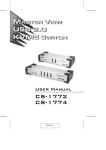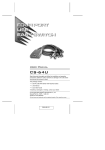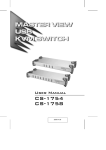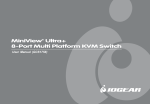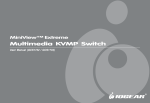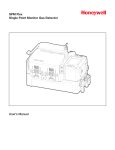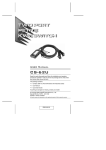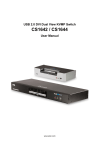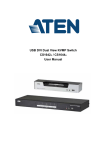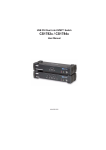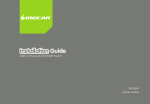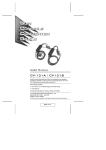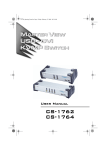Download ATEN MasterView CS-1762 User manual
Transcript
User Manual CS-1762 CS-1764 2004-06-04 NOTE: This equipment has been tested and found to comply with the limits for a Class B digital device pursuant to Subpart J of Part 15 of the FCC Rules. These limits are designed to provide reasonable protection against harmful interference in a residential installation. This equipment generates, uses and can radiate radio frequency energy and, if not installed and used in accordance with the instructions, may cause harmful interference to radio communications. However, there is no guarantee that interference will not occur in a particular installation. If this equipment does cause harmful interference to radio or television reception, which can be determined by turning the equipment off and on, the user is encouraged to try to correct the interference by one or more of the following measures: M Reorient or relocate the receiving antenna. M Increase the separation between the equipment and receiver. M Connect the equipment into an outlet on a circuit different from that which the receiver is connected. M Consult the dealer or an experienced radio/television technician for help. 2004-06-04 CS-1762 / CS-1764 User Manual Packing List The complete Master View CS-1762 / CS-1764 package consists of: M 1 CS-1762 or CS-1764 KVMP Switch M 2 CS Custom KVM Cables (CS-1762) M 4 CS Custom KVM Cables (CS-1764) M 1 Firmware Upgrade Cable M 1 Power Adapter M 1 User Manual M 1 Quick Start Guide Check to make sure that all the components are present and that nothing was damaged in shipping. If you encounter a problem, contact your dealer. Read this manual thoroughly and follow the installation and operation procedures carefully to prevent any damage to the unit, and/or any of the devices that connect to it. ©Copyright 2004 ATEN® International Co., Ltd. Manual Part No. PAPE-0231-1AT Printed in Taiwan 06/2004 All brand names and trademarks are the registered property of their respective owners. iii 2004-06-04 CS-1762 / CS-1764 User Manual Contents 1. Introduction Overview . . . . . . . . . . . . Features . . . . . . . . . . . . . Hardware Requirements . . . . Console . . . . . . . . . . Computer . . . . . . . . . Cables . . . . . . . . . . . CS-1762 Front View . . . . . . CS-1764 Front View . . . . . . CS-1762 / CS-1764 Rear View . . . . . . . . . . . . . . . . . . . . . . . . . . . . . . . . . . . . . . . . . . . . . . . . . . . . . . . . . . . . . . . . . . . . . . . . . . . . . . . . . . . . . . . . . . . . . . . . . . . . . . . . . . . . . . . . . . . . . . . . . . . . . . . . . . . . . . . . . . . . . . . . . . . . . . . . . . . . . . . . . . . . . . . . . . . . . . . . . . . . . . . . . . . . . 1 2 3 3 3 3 4 5 6 2. Installation Before you Begin . . . . . . . . . . . . . . . . . . . . . . . . . . . . . 8 Cable Connection . . . . . . . . . . . . . . . . . . . . . . . . . . . . . 8 3. Basic Operation Manual Switching . . . . . Hot Plugging . . . . . . . . Powering Off and Restarting Port ID Numbering . . . . . . . . . . . . . . . . . . . . . . . . . . . . . . . . . . . . . . . . . . . . . . . . . . . . . . . . . . . . . . . . . . . . . . . . . . . . . . . . . . . . . . . . . . . . . 11 11 12 12 4. Hotkey Operation Port Switching . . . . . . . . . . . . Cycling Through the Ports . . . Going Directly to a Port . . . . . Auto Scanning . . . . . . . . . Hotkey Setting Mode . . . . . . . . . Invoking HSM . . . . . . . . . Alternate HSM Invocation Keys Alternate Port Switching Keys . Keyboard Operating Platform . List Hotkey Settings . . . . . . USB Reset . . . . . . . . . . . . Hotkey Beeper Control . . . . . Disable Port Switching Keys . . Firmware Upgrade Mode . . . . Restore Default Settings . . . . HSM Summary Table . . . . . . Mac Keyboard Emulation . . . . . . . . . . . . . . . . . . . . . . . . . . . . . . . . . . . . . . . . . . . . . . . . . . . . . . . . . . . . . . . . . . . . . . . . . . . . . . . . . . . . . . . . . . . . . . . . . . . . . . . . . . . . . . . . . . . . . . . . . . . . . . . . . . . . . . . . . . . . . . . . . . . . . . . . . . . . . . . . . . . . . . . . . . . . . . . . . . . . . . . . . . . . . . . . . . . . . . . . . . . . . . . . . . . . . . . . . . . . . . . . . . . . . . . . . . . . . . . . . . . . . . . . . . . . . . . . . . . . . . . . . . . . . . . . . . . . . . . . . . . . . . . . . . . . . . . 13 13 14 15 16 16 16 17 17 18 18 18 18 19 19 19 20 iv 2004-06-04 CS-1762 / CS-1764 User Manual 5. The Firmware Upgrade Utility Before You Begin . . . . . . . Starting the Upgrade . . . . . . Upgrade Succeeded . . . . . . . Upgrade Failed . . . . . . . . . . . . . . . . . . . . . . . . . . . . . . . . . . . . . . . . . . . . . . . . . . . . . . . . . . . . . . . . . . . . . . . . . . . . . . . . . . . . . . . . . 21 22 25 25 Appendix Specifications . . . . . . Troubleshooting . . . . Hotkey Default Settings Limited Warranty . . . . . . . . . . . . . . . . . . . . . . . . . . . . . . . . . . . . . . . . . . . . . . . . . . . . . . . . . . . . . . . . . . . . . . . . . . . . . . . . . . . . 27 28 29 29 . . . . . . . . . . . . . . . . v 2004-06-04 CS-1762 / CS-1764 User Manual Conventions This manual uses the following conventions: Courier Indicates text that you should key in. [] Indicates keys you should press. For example, [Enter] means to press the Enter key. If keys need to be chorded, they appear together in the same bracket with a plus sign between them: [Ctrl+Alt]. 1. Numbered lists represent procedures with sequential steps. M Bullet lists provide information, but do not involve sequential steps. > Indicates selecting an option on a menu. For example, Start > Run means to open the Start menu, and then select Run. Indicates critical information. vi 2004-06-04 Chapter 1. Introduction Overview The Master View CS-1762 or CS-1764 DVI KVM Switch charts a revolutionary new direction in KVM (Keyboard, Video, Mouse) switch functionality by combining a 2 port (CS-1762) or 4 port (CS-1764) KVM switch with a 2 port USB hub at the same time as it provides an interface for a digital monitor (DVI). As a KVM switch, it allows users to access two or four computers from a single USB keyboard, USB mouse, and monitor console. As a USB hub, it permits each computer to access any peripherals connected to the hub on a ‘one computer at a time’ basis. The CS-1762 / CS-1764’s independent (asynchronous) switching feature, allows the KVM focus to be on one computer while the USB peripheral focus is on another. This eliminate the need to purchase a separate USB hub as well as the need to purchase separate stand-alone peripheral sharers - such as print servers, modem splitters, etc. The CS-1762 / CS-1764 further improves on previous designs with DVI (Digital Visual Interface) connectors, and the transfer of keyboard and mouse data to the computers via a fast, reliable USB connection. DVI supports both digital video input (flat panel displays, data projectors, plasma displays, digital TVs and set-top boxes) and analog video input (traditional monitors and TVs). The CS-1762 / CS-1764 is audio enabled. A single microphone can provide audio input to each of the computers, and you can listen to the audio output of each computer on a single set of speakers (on a one-at-a-time basis). As with the USB peripherals, the audio focus can be independent of the KVMfocus. Setup is fast and easy; simply plug cables into their appropriate ports. There is no software to configure, no installation routines, and no incompatibility problems. Since the CS-1762 / CS-1764 intercepts keyboard input directly, it works on multiple operating platforms (PC compatible and Mac). There are two convenient methods to access the computers: push button port selection switches located on the unit’s front panel; and hotkey combinations entered from the keyboard. There is no better way to save time and money than with a Master View CS-1762 / CS-1764 installation. Since a single console manages all of the computers, the CS-1762 / CS-1764 setup: eliminates the expense of having to purchase separate console components for each computer; saves all the space those extra components would take up; saves on energy costs; and eliminates the inconvenience and wasted effort involved in constantly moving from one computer to another. 1 2004-06-04 CS-1762 / CS-1764 User Manual Features M Dual function KVMP-USB switch M One console controls 2 (CS-1762) or 4 (CS-1764) computers M Independent (asynchronous) switching of KVM and peripheral USB/Audio ports M Fully compliant with the USB 1.1 specification - supports transfer rates of 1.5/12 Mbps M DVI digital and analog monitor support - fully compliant with the DVI specifications M Computer selection via front panel switches and hotkeys M LED display for easy status monitoring M Auto Scan Mode for monitoring all computers M Complete keyboard emulation for error free booting M Superior video quality - 1600 x 1200; DDC2B M Easy installation M Hot pluggable - add or remove computers for maintenance without powering down the switch M Supports Windows and Mac host systems 2 2004-06-04 Introduction Hardware Requirements Console M A DVI monitor capable of the highest resolution that you will be using on any computer in the installation. M A USB style mouse M A USB style keyboard M Microphone and speakers (optional) Computer The following equipment must be installed on each computer: M A DVI port Note: The quality of the display is affected by the quality of the DVI display card. For best results, we recommend you purchase a high quality product. M Type A USB port M Audio ports (optional) Cables Only CS Custom cable sets specifically designed to work with this switch may be used to link to the computers. Two (CS-1762) or four (CS-1764) cable sets are provided with this package. Note: The quality of the display is affected by the quality and length of the cables. If you need additional cable sets, contact your dealer to purchase the correct ones for your switch. 3 2004-06-04 CS-1762 / CS-1764 User Manual CS-1762 Front View 1&2 3 1. Port Selection Switches M Press a switch for longer than two seconds to bring the KVM, USB hub, and audio focus to the computer attached to its corresponding port. M Press a switch for less than two seconds to bring only the KVM focus to the computer attached to its corresponding port. M Press switches 1 and 2 simultaneously for 2 seconds to start Auto Scan Mode. See p. 15 for details. 2. Port LEDs The Port LEDs are built into the Port Selection Switches. The upper ones are the KVM Port LEDs; the lower ones are the USB LEDs: KVM: M Lights DIM ORANGE to indicate that the computer attached to the corresponding port is up and running (On Line). M Changes to BRIGHT ORANGE to indicate that the computer attached to its corresponding port is the one that has the KVM focus (Selected). M Flashes to indicate that the computer attached to its corresponding port is being accessed under Auto Scan mode. USB: M Lights GREEN to indicate that the computer attached to its corresponding port is the one that has access to the USB peripherals. 3. USB Console Ports Your USB keyboard and USB mouse plug in here. 4 2004-06-04 Introduction CS-1764 Front View 1&2 3 1. Port Selection Switches M Press a switch for longer than two seconds to bring the KVM, USB hub, and audio focus to the computer attached to its corresponding port. M Press a switch for less than two seconds to bring only the KVM focus to the computer attached to its corresponding port. M Press switches 1 and 2 simultaneously for 2 seconds to start Auto Scan Mode. See p. 15 for details. 2. Port LEDs The Port LEDs are built into the Port Selection Switches. The upper ones are the KVM Port LEDs; the lower ones are the USB LEDs: KVM: M Lights DIM ORANGE to indicate that the computer attached to the corresponding port is up and running (On Line). M Changes to BRIGHT ORANGE to indicate that the computer attached to its corresponding port is the one that has the KVM focus (Selected). M Flashes to indicate that the computer attached to its corresponding port is being accessed under Auto Scan mode. USB: M Lights GREEN to indicate that the computer attached to its corresponding port is the one that has access to the USB peripherals. 3. USB Console Ports Your USB keyboard and USB mouse plug in here. 5 2004-06-04 CS-1762 / CS-1764 User Manual CS-1762 / CS-1764 Rear View 1 2 3 4 5 1 2 3 4 5 6 2004-06-04 Introduction 1. Firmware Upgrade Port The Firmware Upgrade Cable that transfers the firmware upgrade data from the administrator’s computer to the CS-1762 / CS-1764 plugs into this connector. See p. 21 for firmware upgrading details. 2. USB Hub Section USB peripherals (printers, scanners, etc.) can plug into any available port. 3. Console Port Section The cables from your monitor, microphone, and speakers plug in here. Each connector is marked with an appropriate icon to indicate itself. 4. CPU Port Section The cables that link the switch to your computers plug in here. Each CPU port is comprised of a microphone jack, speaker jack, USB type B socket and a DVI connector. 5. Power Jack The power adapter cable plugs into this jack. 7 2004-06-04 Chapter 2. Installation Before you Begin Make sure that all devices on the installation are properly grounded. Cable Connection To set up your Master View CS-1762 / CS-1764 installation, refer to the installation diagrams on the following pages (the numbers in the diagrams correspond to the steps, below), and do the following: 1. Plug your USB keyboard and USB mouse into the USB Console Ports located on the unit’s front panel. 2. Plug your microphone, speakers, and monitor into the Console ports located on the unit’s rear panel. 3. Using a KVM cable set (provided with this package), plug the DVI connector into any available DVI socket in the CPU Port section of the switch, and plug the accompanying USB, microphone and speaker connectors into the corresponding USB, microphone, and speaker sockets. Note: 1. Be sure that all the plugs are in the same CPU Port sockets (all in Port 1, all in Port 2, etc.). 2. Each socket is marked with an appropriate icon to indicate itself. 4. At the other end of the cable, plug the USB, video, microphone and speaker cables into their respective ports on the computer. 5. Plug your USB peripherals into the type A sockets in the USB hub section. 6. Plug the the power adapter that came with your switch into an AC power source, then plug power adapter cable into the switch’s Power Jack. 7. Turn on the power to the computers. 8 2004-06-04 Installation 1 5 2 6 3 2 4 9 2004-06-04 CS-1762 / CS-1764 User Manual Notes: 10 2004-06-04 Chapter 3. Basic Operation Manual Switching There are two convenient methods to access the computers: Manual - which involves pressing the pushbutton port selection switches located on the unit’s front panel; and Hotkey - which involves entering combinations from the keyboard. Hotkey port selection is discussed in the next chapter. For manual port selection: M Press and release a port selection switch to bring the KVM focus to the computer attached to its corresponding port. The USB and Audio focus does not change - they stay with the port that they are already on. M Press and hold a port selection switch for more than 2 seconds to bring the KVM focus, plus the USB and Audio focus to the computer attached to its corresponding port. M Press and hold port selection switches 1 and 2 for more than 2 seconds to start Auto Scan Mode (see p. 15 for Auto Scan Mode details). M Press and release either port selection switch to stop Auto Scan Mode. The KVM focus goes to the computer attached to the corresponding port of the switch you pressed. Hot Plugging The Master View CS-1762 / CS-1764 supports USB hot plugging - components can be removed and added back into the installation by unplugging their cables from the USB hub ports without the need to shut the unit down. 11 2004-06-04 CS-1762 / CS-1764 User Manual Powering Off and Restarting If it becomes necessary to Power Off the Master View unit, before starting it back up you must do the following: 1. Shut down all the computers that are attached to the switch. 2. Unplug the switch’s power adapter cable. 3. Wait 10 seconds, then plug the switch’s power adapter cable back in. 4. After the switch is up, Power On the computers. Port ID Numbering Each CPU port on the CS-1762 / CS-1764 switch is assigned a port number (1 or 2 for the CS-1762; 1 to 4 for the CS-1764). The port numbers are marked on the rear panel of the switch (see p. 6). The Port ID of a computer is derived from the CPU port number it is connected to. For example, a computer connected to CPU port 2 has a Port ID of 2. The Port ID is used to specify which computer gets the KVM USB peripheral, and audio focus with the Hotkey port selection method (see Going Directly to a Port, p. 14, for details). 12 2004-06-04 Chapter 4. Hotkey Operation The CS-1762 / CS-1764 provides an extensive, easy-to-use, hotkey function that makes it convenient to control and configure your KVM installation from the keyboard. Hotkeys provide asynchronous (independent) switching of the KVM, USB hub and audio focus. If you wish, you can give one computer the KVM console focus, another the USB hub focus, while a third has the audio focus. Port Switching All port switches begin with tapping the Scroll Lock key twice. The tables below describe the actions that each combination performs. Note: If using the Scroll Lock key conflicts with other programs running on the computer, the Ctrl key can be used, instead. See Alternate Port Switching Keys, p. 17 for details. Cycling Through the Ports Hotkey [Scroll Lock] [Scroll Lock] [Enter] Action Brings the KVM, USB hub, and audio focus from the port that currently has the KVM focus to the next port on the installation (1 to 2; 2 to 1 for the CS-1762; 1 to 2; 2 to 3; 3 to 4; 4 to 1 for the CS-1764). Note that the KVM, USB hub, and audio focus all go to this port even if they were on different ports to begin with. [Scroll Lock] [Scroll Lock] [K] [Enter] Brings only the KVM focus from the port that currently has it to the next port on the installation. The USB hub and audio focus remain where they are. [Scroll Lock] [Scroll Lock] [U] [Enter] Brings only the USB hub focus from the port that currently has it to the next port on the installation. The KVM and audio focus remain where they are. [Scroll Lock] [Scroll Lock] [S] [Enter] Brings only the audio focus from the port that currently has it to the next port on the installation. The KVM and USB hub focus remain where they are. 13 2004-06-04 CS-1762 / CS-1764 User Manual Going Directly to a Port Hotkey [Scroll Lock] [Scroll Lock] [n] [Enter] Action Brings the KVM, USB hub, and audio focus to the computer attached to the port corresponding to the specified Port ID. Note that the KVM, USB hub, and audio focus all go to this port even if they were on different ports to begin with. [Scroll Lock] [Scroll Lock] [n] [K] [Enter] Brings only the KVM focus to the computer attached to the specified port. The USB hub and audio focus remain where they are. [Scroll Lock] [Scroll Lock] [n] [U] [Enter] Brings only the USB hub focus to the computer attached to the specified port. The KVM and audio focus remain where they are. [Scroll Lock] [Scroll Lock] [n] [S] [Enter] Brings only the audio focus to the computer attached to the specified port. The KVM and USB hub focus remain where they are. [Scroll Lock] [Scroll Lock] [n] [K] [U] [Enter] Brings the KVM and USB hub focus to the computer attached to the specified port. The audio focus remains where it is. [Scroll Lock] [Scroll Lock] [n] [K] [S] [Enter] Brings the KVM and audio focus to the computer attached to the specified port. The USB hub focus remains where it is. [Scroll Lock] [Scroll Lock] [n] [U] [S] [Enter] Brings the USB hub and audio focus to the computer attached to the specified port. The KVM focus remains where it is. Note: The n stands for the computer’s Port ID number (1, 2, 3, or 4 - see Port Numbering, p. 12). Replace the n with the appropriate Port ID when entering hotkey combinations. 14 2004-06-04 Hotkey Operation Auto Scanning The CS-1762 / CS-1764’s Auto Scan feature automatically cycles the KVM focus through the computer ports at regular intervals. This allows you to monitor the computer activity without having to take the trouble of switching from port to port manually. See the table below for details. Hotkey Action [Scroll Lock] [Scroll Lock] [A] [Enter] Starts Auto Scan. The KVM focus cycles from port to port at 5 second intervals. [Scroll Lock] [Scroll Lock] [A] [n] [Enter] Starts Auto Scan. The KVM focus cycles from port to port at n second intervals. Note: 1. The n stands for the number of seconds that the CS-1762 / CS-1764 should dwell on a port before moving on to the next. Replace the n with a number between 1 and 99 when entering this hotkey combination. 2. While Auto Scan Mode is in effect, ordinary keyboard and mouse functions are suspended - only Auto Scan Mode compliant keystrokes and mouse clicks can be input. You must exit Auto Scan Mode in order to regain normal control of the console. 3. Although the video focus switches from port to port, the keyboard, mouse, and USB focus doesn’t switch. They stay at the port they were on when Auto Scanning started. 15 2004-06-04 CS-1762 / CS-1764 User Manual Hotkey Setting Mode Hotkey Setting Mode is used to set up your CS-1762 / CS-1764 switch configuration. All operations begin with invoking Hotkey Setting Mode (HSM). Invoking HSM To invoke HSM do the following: 1. Press and hold down the Num Lock key 2. Press and release the minus key 3. Release the Num Lock key Note: 1. There is an alternate key combination to invoke HSM. See below for details. 2. The minus key must be released within one half second, otherwise Hotkey invocation is canceled. When HSM is active, the Caps Lock, and Scroll Lock LEDs flash in succession to indicate that HSM is in effect. They stop flashing and revert to normal status when you exit HSM. Ordinary keyboard and mouse functions are suspended - only Hotkey compliant keystrokes and mouse clicks (described in the sections that follow), can be input. At the conclusion of some hotkey operations, you automatically exit hotkey mode. With some operations, you must exit manually. To exit HSM manually, press the Esc key, or the Spacebar. Alternate HSM Invocation Keys An alternate set of HSM invocation keys is provided in case the default set conflicts with programs running on the computers. To switch to the alternate HSM invocation set, do the following: 1. Invoke HSM (see above) 2. Press and release the H key The HSM invocation keys become the Ctrl key (instead of Num Lock) and the F12 key (instead of minus). Note: This procedure is a toggle between the two methods. To revert back to the original HSM invocation keys, invoke HSM, then press and release the H key again. 16 2004-06-04 Hotkey Operation Alternate Port Switching Keys The port switching activation keys can be changed from tapping the Scroll Lock key twice ([Scroll Lock] [Scroll Lock]) to tapping the Ctrl key twice. To change the port switching activation keys, do the following: 1. Invoke HSM (see p. 16) 2. Press and release the T key Note: This procedure is a toggle between the two methods. To revert back to the original [Scroll Lock] [Scroll Lock] method, invoke HSM, then press and release the T key again. Keyboard Operating Platform The CS-1762 / CS-1764’s default port configuration is for a PC Compatible keyboard operating platform. If you have a Mac attached to a port, you can change a port’s keyboard operating platform configuration as follows: 1. Bring the KVM focus to the port you want to set. 2. Invoke HSM (see p. 16) 3. Press and release the appropriate Function key (see table). After completing a setting, you automatically exit HSM. Function Key Operation [F2] Sets the Mac keyboard operating platform. [F10] Auto detects the keyboard operating platfrom (for PC compatible systems). 17 2004-06-04 CS-1762 / CS-1764 User Manual List Hotkey Settings To see a listing of the current hotkey settings, do the following: 1. Invoke HSM (see p. 16). 2. Press and release the F4 function key. 3. Open a text editor or word processor and use its Paste function to display the settings. USB Reset If the USB loses focus and needs to be reset, do the following: 1. Invoke HSM (see p. 16). 2. Press and release the F5 function key. Hotkey Beeper Control The Beeper can be hotkey toggled On and Off. To toggle the Beeper, do the following: 1. Invoke HSM (see p. 16). 2. Press and release the B key. The Beeper toggles On or Off. The Command Line displays Beeper On or Beeper Off for one second; then the message disappears and you automatically exit Hotkey Mode. Disable Port Switching Keys To disable the Port Switching Keys ([Scroll Lock] [Scroll Lock] / [Ctrl] [Ctrl]), do the following: 1. Invoke HSM (see p. 16). 2. Press [X] [Enter]. Note: This procedure is a toggle. To enable the Port Switching keys repeat steps 1 and 2. 18 2004-06-04 Hotkey Operation Firmware Upgrade Mode To set the CS-1762 / CS-1764 to Firmware Upgrade Mode, do the following: 1. Invoke HSM (see p. 16). 2. Key in: upgrade 3. Press [Enter]. The front panel LEDs flash to indicate Firmware Upgrade Mode is in effect. Note: To exit Firmware Upgrade Mode, you must power off the switch. Restore Default Settings To reset the CS-1762 / CS-1764 to its default hotkey settings, do the following: 1. Invoke HSM (see p. 16). 2. Press [R] [Enter]. All hotkey settings return to the factory default settings. See p. 29 for a list of default settings. HSM Summary Table After invoking HSM (see p. 16), key in one of the following keys to perform the corresponding function: Key Function H Toggles between the default and alternate HSM invocation keys. T Toggles between the default and alternate Port Switching keys. F2 Sets the Mac keyboard operating platform. F10 Auto detects the keyboard operating platfrom. (PC Compatibles) F4 Lists the current hotkey settings via the Paste function of a text editor or WP. F5 Performs a USB reset. B Toggles the beeper On and Off. X [Enter] Enables/Disables the Port Switching keys. R [Enter] Resets the hotkey settings to their default status. upgrade [Enter] Invokes Firmware Upgrade Mode 19 2004-06-04 CS-1762 / CS-1764 User Manual Mac Keyboard Emulation The PC Compatible (101/104 key) keyboard can emulate the functions of the Mac keyboard. The emulation mappings are listed in the table below. Note: When using key combinatons, press and release the first key (Ctrl or Alt), then press and release the activation key. PC Keyboard Mac Keyboard [Shift] Shift [Ctrl] Ctrl [Win] [Ctrl] [F4] [Alt] L Alt/Option [Prt_Sc] F13 [Scroll Lock]* F14 [Desktop Menu] = [Enter] Return [Back Space] Delete [Ins] Help [Ctrl] [Desktop Menu] F15 * If you are using Mac keyboard emulation, we recommend using the alternate port switching keys (see p. 17), to avoid a conflict with the Scroll Lock key. 20 2004-06-04 Chapter 5. The Firmware Upgrade Utility The Windows-based Firmware Upgrade Utility (FWUpgrade.exe) provides a smooth, automated process for upgrading the KVM switch’s firmware. The Utility comes as part of a Firmware Upgrade Package that is specific for each device. New firmware upgrade packages are posted on our web site as new firmware revisions become available. Check the web site regularly to find the latest packages and information relating to them: http://www.aten.com.tw Before You Begin To prepare for the firmware upgrade, do the following: 1. From a computer that is not part of your KVM installation go to our Internet support site and choose the model name that relates to your device (CS-1762 or CS-1764) to get a list of available Firmware Upgrade Packages. 2. Choose the Firmware Upgrade Package you want to install (usually the most recent), and download it to your computer. 3. Use the Firmware Upgrade Cable provided with this unit, to connect a COM port on your computer to the Firmware Upgrade Port of your switch. 21 2004-06-04 CS-1762 / CS-1764 User Manual 4. Shut down the computers on your CS-1762 / CS-1764 installation. 5. Invoke Firmware Upgrade Mode (see p. 19). The front panle LEDs flash together to indicate Firmware Upgrade Mode is in effect. Starting the Upgrade To upgrade your firmware: 1. Run the downloaded Firmware Upgrade Package file - either by double clicking the file icon, or by opening a command line and entering the full path to it. The Firmware Upgrade Utility Welcome screen appears: Note: The screens shown in this section are for reference only. The wording and layout of the actual screens put up by the Firmware Upgrade Utility may vary slightly from these examples. 2. Read and Agree to the License Agreement (enable the I Agree radio button). 22 2004-06-04 The Firmware Upgrade Utility 1. Click Next to continue. The Firmware Upgrade Utility main screen appears: The Utility inspects your installation. All the devices capable of being upgraded by the package are listed in the Device List panel. 2. As you select a device in the list, its description appears in the Device Description panel. 23 2004-06-04 CS-1762 / CS-1764 User Manual 3. After you have made your device selection(s), Click Next to perform the upgrade. If you enabled Check Firmware Version, the Utility compares the device’s firmware level with that of the upgrade files. If it finds that the device’s version is higher than the upgrade version, it brings up a dialog box informing you of the situation and gives you the option to Continue or Cancel. If you didn’t enable Check Firmware Version, the Utility installs the upgrade files without checking whether they are a higher level, or not. As the Upgrade proceeds status messages appear in the Status Messages panel, and the progress toward completion is shown on the Progress bar. 24 2004-06-04 The Firmware Upgrade Utility Upgrade Succeeded After the upgrade has completed, a screen appears to inform you that the procedure was successful: Click Finish to close the Firmware Upgrade Utility. After a successful completion, the switches exit Firmware Upgrade Mode, and reset themselves. Upgrade Failed If the Upgrade Succeeded screen doesn’t appear, it means that the upgrade failed to complete successfully, in which case you should repeat the upgrade procedure from the beginning. 25 2004-06-04 CS-1762 / CS-1764 User Manual Notes: 26 2004-06-04 Appendix Specifications Function CS-1762 CS-1764 Computer Connections 2 CPU Port Selection Front Panel Switches; Hotkey LEDs On Line/Selected 2 (Orange) 4 (Orange) USB Link 2 (Green) 4 (Green) Keyboard 1 x USB Type A socket Mouse 1 x USB Type A socket Video 1 x DVI-I (female) port Audio 1 x Stereo earphone jack 1 x Microphone jack KB / Mouse 2 x USB Type B sockets 4 x USB Type B sockets Video 2 x DVI-I ports (female) 4 xx DVI-I ports (female) Audio 2 x Stereo earphone jacks 2 x Microphone jacks 4 x Stereo earphone jacks 4 x Microphone jacks Console Connectors Computer Connectors 4 USB Peripherals 2 x USB Type A sockets Firmware Upgrade 1 x 4-bin earphone jack Power Adapter 1 x DC 5V jack Scan Interval 1 - 99 secs. (5 secs. default) Keyboard / Mouse Emulation USB Resolution Up to 1600 x 1200; DDC2B Operating Temperature 0 - 50o C Storage Temperature -20 - 60o C Humidity 0 - 80% RH Housing Metal Weight 0.8kg 1kg Dimensions (L x W x H) 20.0 x 7.45 x 4.2cm 26 x 7.45 x 4.2cm 27 2004-06-04 CS-1762 / CS-1764 User Manual Troubleshooting Symptom Possible Cause Action Erratic behavior. Unit not receiving enough power. Use a DC 5V power adapter if you are not already using one. If you are already using a power adapter, check that it matches the system specifications (DC 5V), and that it is plugged in and functioning properly. Keyboard and/or Mouse not responding. Keyboard and/or mouse need to be reset. Press and hold port selection switches 1 and 2 for two seconds. (CS-1734 only.) No connection to the computer. Check the cable from the switch to the computer to make sure it is properly connected. KVM switch needs to be reset. Power off all devices on the installation (see the note at the top of p. 8); power off the KVM switch; wait five seconds; then power up. USB ports need to be reset. Unplug the device’s USB cable from the USB port on the switch’s rear panel, then plug it back in. USB devices not responding. Unplug the cable(s) from the console port(s), then plug it/them back in. Use the USB Reset hotkey combination (see p. 18), to reset the USB ports. 28 2004-06-04 The Firmware Upgrade Utility Hotkey Default Settings The hotkey factory default settings are given in the table below: Setting Default Port Switching [Scroll Lock] [Scroll Lock] Invoking HSM [Num Lock] [ - ] Beeper On Keyboard Operating Platform PC Compatible Port Switching Keys Enabled Limited Warranty IN NO EVENT SHALL THE DIRECT VENDOR’S LIABILITY EXCEED THE PRICE PAID FOR THE PRODUCT FROM THE DIRECT, INDIRECT, SPECIAL, INCIDENTAL OR CONSEQUENTIAL DAMAGES RESULTING FROM THE USE OF THE PRODUCT, DISK OR ITS DOCUMENTATION. The direct vendor makes no warranty or representation, expressed, implied, or statutory with respect to the contents or use of this documentation, and specially disclaims its quality, performance, merchantability, or fitness for any particular purpose. The direct vendor also reserves the right to revise or update the device or documentation without obligation to notify any individual or entity of such revisions, or update. For further inquires please contact your direct vendor. 29 2004-06-04



































